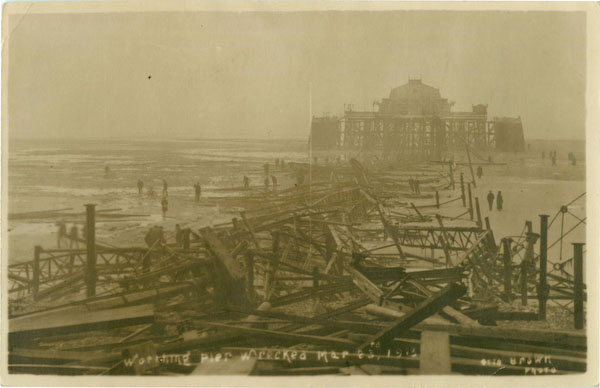Otto Brown

Wreck of Worthing Pier, March 23, 1913
Photographer and entertainer, 2 Chapel Road and Marine Parade, Worthing. Brown was born in 1883 at Long Sutton in Somerset, and after leaving school worked as an artist and photographer in Hampshire. On June 18, 1905, he married Edith Mary Hiscocks at St Barnabas Church in Hove. Edith was at least a year older than Otto (possibly four years older) and was the daughter of Harry Hiscocks, a commercial traveller. Both bride and groom gave their address as 76 Coleridge Street in Hove. Edith, who had been born in St John's Wood in London, had in 1901 lived with her parents in Saffron Walden in Essex, working as a cashier for an international tea company. Why she then moved to Hove is not known. On the marriage certificate, Otto's father, Charles Brown, is described as a farmer, but other archival sources suggest he was a beer seller and grocer.
Otto and Edith Brown did not stay long in Hove. Later in 1905 Otto entered into a partnership with Leon Balk, a Jewish émigré from Lithuania, to run a studio, called Balk & Brown (later the Devonshire Studio), at 69a Devonshire Road in Bexhill-on-Sea (see David Simkin's website http://photohistory-sussex.co.uk). Balk already had a studio in Langney Road in Eastbourne and this may have left him with all too little time to help Brown run the new Bexhill studio. Brown may have felt let down by Balk, or perhaps he had other reasons for abandoning the partnership, but after only about a year he moved to Worthing and established a studio of his own at 2 Chapel Road. Balk then closed down his Eastbourne studio and ran the Bexhill business on his own.
At Worthing, Otto Brown like Balk seems to have concentrated on portrait photography, but with somewhat less emphasis on studio work. He published a range of real photographic cards showing concert parties and local entertainers, as well as popular tourist venues, such as the High Salvington Tea Rooms. He also covered local disasters such as the storm damage to Worthing Pier in March 1913 and a fire at a local timber yard in October 1919. A series of captionless cards show a man performing stunt dives (the "Roll-up Dive", "Swedish Swallow Dive", etc.) at the end of Worthing Pier. In April 1921 Otto Brown recorded the unveiling of the town's war memorial. Some of his earliest cards have his name and address blind stamped (impressed) at the base of the pictures, but later he usually wrote his name on his pictures next to the captions or across a corner, or issued the cards anonymously. Most cards have borders.
In addition to his real photographics, Brown published coloured halftone cards of Worthing with captions printed in red. The pictures have white, textured borders set in a rather lurid purple surround. They are labelled on the back "Published by Otto Brown, Worthing". A 1913 postmark has been reported.
Brown contributed a number of photographs to J. Lee Osborn's Homeland Handbook, Worthing and its surroundings (third edition, 1923, Homeland Association, London), including a view of Chapel Road, where he had his studio, and the Worthing lifeboat in a rough sea. The photographs show that Brown had an eye for picturesque compositions, and it is a pity that he did not issue more of his photographs as real photographic cards.
Brown did not confine his business activities to his Chapel Road studio. In 1909 the Swiss-born violinist and impresario, Carl Adolph Seebold (1873-1951), opened the Kursaal entertainment centre on Marine Parade. This boasted a meeting hall and roller-skating rink, later converted into a theatre and cinema. Otto Brown seized the opportunity to set up a photographic, toy and fancy goods shop next door to the Kursaal, which he called the Kursaal Bazaar. Being so close at hand, he was able to photograph many of the entertainers that appeared on the stage and sell souvenir cards in his shop. Brown seems to have closed the shop during the First World War, when, because of anti-German feeling, the Kursaal's name was tactfully changed to the Dome.
A short distance west of the Kursaal was Worthing Pier. Rob Blann in his Vintage Worthing (2001, privately published, p. 20) records that Brown opened a little wooden studio beside the entrance to the Pier where he could photograph passing holidaymakers. Next to the studio he set up an amusement stall, which featured a new game called the Climbing Monkeys. To supplement his income further, he acted as an "amusement caterer" supplying fetes, galas, flower shows and other big social gatherings with a large variety of "high-class" games designed to provide "endless amusement".
When the 1911 census was held, Brown had been married for 6 years, but did not have any children. He employed 23-year-old William Hiscocks from London as a photographic assistant. William was presumably a relative of Otto's wife, but the precise nature of the relationship is unclear (Edith is known to have had a brother, but he was not called William).
Pike's 1931-32 Worthing Directory gives Otto Brown's address as 1 Ann Street and 2 Chapel Road. Within a few years he moved from Chapel Road to Prospect Place in Worthing, where he could more conveniently store all the games that he hired out. He died at Worthing in late 1938, aged only 51.
For a fuller account of Brown's life and his work as a studio portraitist you are recommended to visit David Simkin's excellent website www.photohistory-sussex.co.uk.
To directory of publishersTo gallery
Design: Lucid Design
© www.sussexpostcards.info
